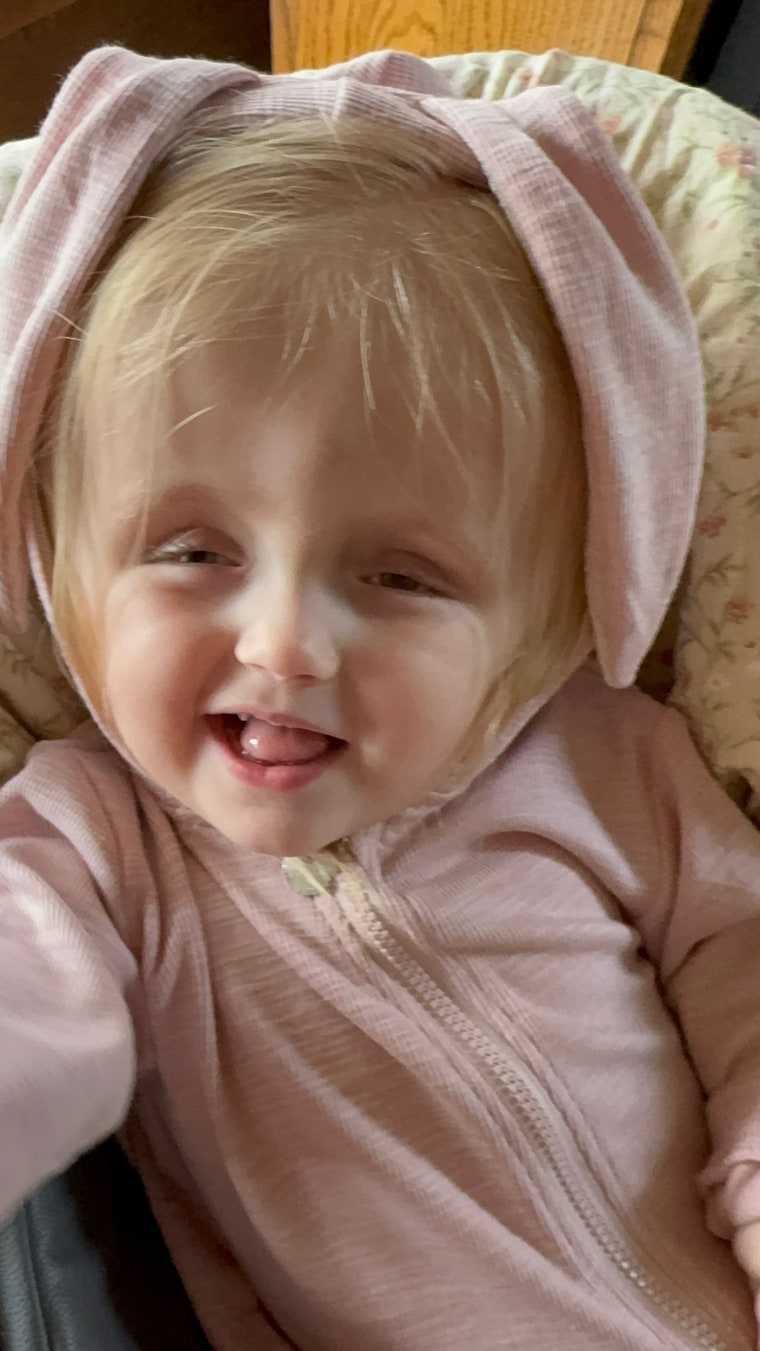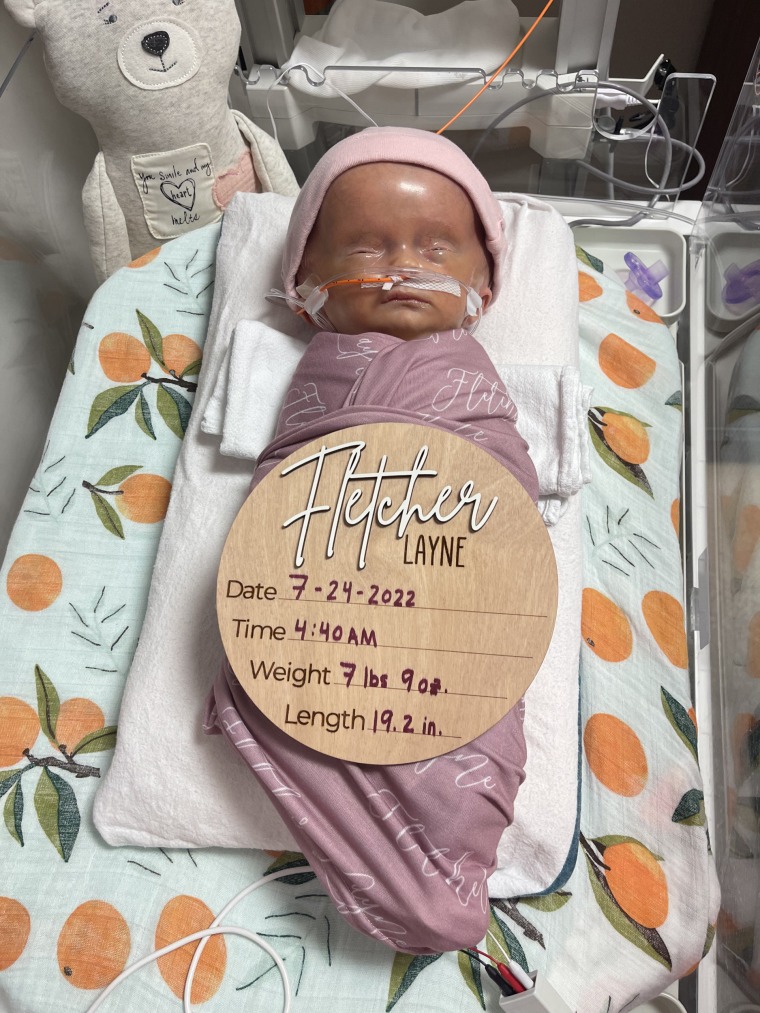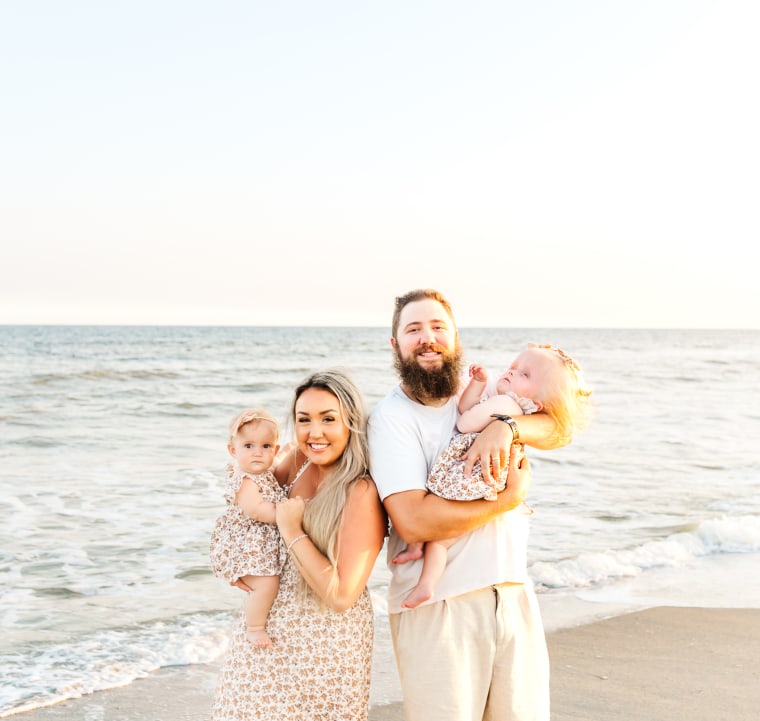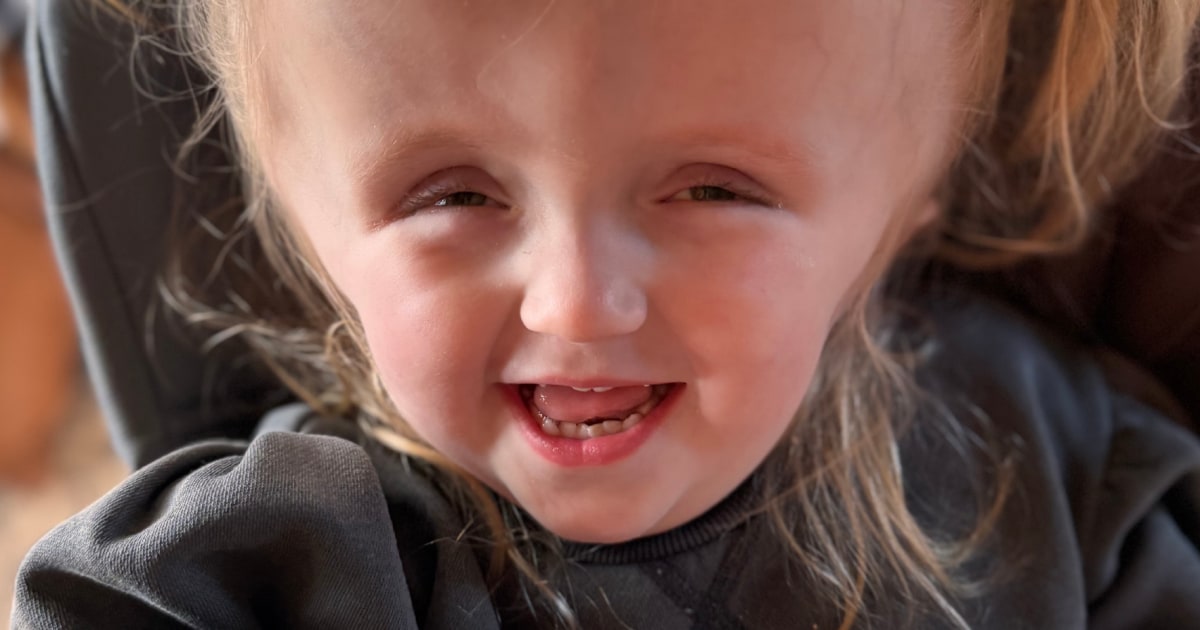When Billy and Stevee Fazenbaker’s daughter Fletcher was born in July 2022, they immediately knew something was wrong with the baby.
“When she came out, her head was very, very big,” Stevee Fazenbaker, 29, of Garrett County, Maryland, tells TODAY.com. “She was in critical condition right away.”
Doctors performed an MRI, which revealed that Fletcher had a brain tumor so large that it made her head increase in size.
“The doctors were like, ‘We’re so sorry, but there is nothing that we can do … we think you should go home (with her) on hospice and just enjoy your time,’” Stevee Fazenbaker says. “That’s the worst news you can get.”
‘An Extremely Heavy Time’
Billy and Steeve Fazenbaker were excited to welcome their first child into the world. Pregnancy was easy for Stevee Fazenbaker.
“I felt good the whole time. I was considered low risk,” Stevee Fazenbaker says. “My last scan was at 20 weeks and she was measuring perfectly and looked great.”
During her remaining prenatal appointments, everything seemed as if it was going well and “there were no red flags,” Stevee Fazenbaker recalls.
When Stevee Fazenbaker’s water broke, she went to the hospital, but labor didn’t progress as it should have. Doctors recommended she undergo a cesarean section to deliver the baby, and Stevee Fazenbaker agreed. When Fletcher was born, the Fazenbakers knew she looked different than other newborns.
“It was a complete shock when she was born that anything was wrong,” Stevee Fazenbaker says. “Our initial thought was, ‘OK, her head’s really big. Maybe it’s hydrocephalus.”
Hydrocephalus occurs when cerebral spinal fluid builds up in the brain, according to the Hydrocephalus Association. That can enlarge the head.
Doctors took Fletcher to the neonatal intensive care unit to stabilize her, and the next day, she underwent an MRI, which revealed she had a brain tumor.
“It was an extremely heavy time,” Stevee Fazenbaker says.
After about a week, doctors said the family could take Fletcher home for hospice care.
“They prepared us for a two-week life expectancy,” Billy Fazenbaker, 30, tells TODAY.com. “They told us initially she would decline immediately. The meds would go up and up, and up and she would pass in her sleep.”
The tumor rested near Fletcher’s brain stem, and doctors thought the mass would encroach on it, which could eventually stop the infant’s breathing.
“It was a miracle in itself that we made it home,” Stevee Fazenbaker says. “We came home and tried to live life with her.”
The couple prioritized showing their daughter as much as possible in what they thought would be her short life. When it rained, they took Fletcher — hooked to oxygen and a feeding tube — outside so she could feel the rain. Even though doctors thought Fletcher would never be able to suck, her parents gave her a pacifier, which she sucked. So, they gave her a bottle, and she drank it. Fletcher did many things that doctors told the Fazenbakers she’d never do.
“(By the first week’s) end, she’s already doing a couple (of) normal baby things, which was amazing,” Stevee Fazenbaker says.
About a month passed, and then Fletcher and the family returned to the hospital to see if the baby could undergo another MRI or they could receive “some form of clarity that we were doing the right thing,” Stevee Fazenbaker says.
“They said, ‘Just soak up your time. Sometimes when they’re in a home environment, a loving environment, they can do well for a little bit a time. But there’s nothing we can do,’” Stevee Fazenbaker recalls. “They wouldn’t even place a shunt in her.”
Her parents had hoped a shunt, a surgically implanted tube that helps to drain cerebrospinal fluid from the brain, could reduce some of the pressure in Fletcher’s brain. Doctors didn’t believe the infant could survive the surgery.
“She was alive, and we were loving it,” Billy Fazenbaker says. “But (we were) almost grieving her while she was alive.”
When Fletcher turned 2 months old, the Fazenbakers wanted a second opinion and contacted a “reputable” hospital for a consultation. They were devastated by that meeting.
“The doctor was like, ‘Look, I don’t even think it’s worth you driving here after seeing her through Zoom. I agree with (the hospital) where you delivered opinion, and I think you should enjoy your time,’” Stevee Fazenbaker recalls. “His exact words were, ‘You wouldn’t be doing something for her. You would be doing something to her.’”

Stunned, the couple processed the news as best they could. They were “literally begging God for a walk-on-water miracle.” Soon after Fletcher turned 3 months old, their hospice nurse mentioned St. Jude Children’s Research Hospital and asked if the couple had reached out to them. Immediately, they filled out an application for a second opinion. Forty-eight hours later, they received a call.
“She’s like, ‘So I think we can help you.’ How soon can you get here,’” Stevee Fazenbaker says. “(It) was the most exciting thing ever.”
The couple drove to Memphis and was stunned by what Dr. Aditi Bagchi told them when they met in November 2022.
“She was like, ‘This is going to be a really bumpy road, but I think we can cure her,’” Stevee Fazenbaker says. “We went from hearing, ‘Go home on hospice and enjoy your time’ to ‘I think I can save your baby.’”
Bagchi believed that Fletcher had an infant-type hemispheric glioma, a tumor that she could treat.
Infant-Type Hemispheric Gliomas
Until recently, doctors would sometimes see newborns, like Fletcher, with high-grade gliomas. Doctors thought that these brain tumors were the same as the aggressive brain tumor known as glioblastoma that occurs in older children and adults. But clinical observations and ongoing research indicated that these gliomas found in infants behave differently. In 2021, doctors named them infant-type hemispheric gliomas to differentiate them from glioblastomas.
“Research over the last decade or so has slowly given us hints that these tumors, which these little babies are getting, are different from the glioma that we see in older individuals,” Bagchi, a neuro-oncologist at St. Jude Children’s Research Hospital, tells TODAY.com. “It’s a relatively new … reclassification.”

Doctors first noticed a difference between glioblastoma in older populations and infant-type hemispheric gliomas because the infant tumors responded better to surgery and chemotherapy. With new DNA and RNA sequencing methods, experts were able to confirm that the infant-grade hemispheric gliomas have “different genetic drivers” than glioblastomas.
“Their genome looks very different from the high-grade gliomas diagnosed in older children,” Bagchi explains.
As they are rare and newly classified, there’s a lack of awareness about infant-type hemispheric gliomas among doctors which could lead to delayed diagnosis, as in Fletcher’s case. It’s not uncommon for parents to hear the same devastating news the Fazenbakers did — that there is nothing doctors can do to help their infant.
“When you look at these babies and their MRIs, these tumors are huge and they are scary looking,” Bagchi says. “They are misdiagnosed a lot of times.”
Bagchi says it’s important to raise awareness of infant-type hemispheric gliomas so that doctors in community hospitals can direct these patients to children’s hospitals for treatment.
“You don’t have to know how to cure it,” she says. “You just have to reach out to us.”
Signs of infant-type hemispheric gliomas often are not present until birth. Though prenatal scans can sometimes identify a blood clot in the brain or detect that the head is larger than usual. In some cases, babies are born with normal-sized heads, but they begin growing larger. In babies who are not diagnosed at birth, they can experience signs including:
- Weakness on one side of the body
- Not being able to eat or drink
- A bulging soft spot on the head
Treatment depends on the “molecular characteristics” of the tumor found upon biopsy of the tumor. Some tumors have genetic markers that respond to targeted therapy, while chemotherapy treats tumors without those markers. When the tumor shrinks, doctors can remove the mass from the brain.
Delayed treatment can lead to developmental delays for many babies. But still, their tumors can be treated.
“It is life-saving for them to appropriately diagnose them and treat them,” Bagchi says.
In early 2026, Bagchi is launching a clinical trial to develop a standardized treatment protocol for infant-type hemispheric glioma.
‘Just Incredible’
When Fletcher met Bagchi, the infant’s head was the size of a 5-year-old’s. Immediately, doctors scheduled a surgery to place a shunt in Fletcher’s brain to drain some of the excess fluid and reduce some of the pressure. Since the skin on Fletcher’s skull was very thin from “her head expanding,” doctors worried about the shunt staying in place — yet it did. Recovering from surgery was still tough.
“It was a really bumpy road after that,” Stevee Fazenbaker says. “She had sodium issues and really was unstable because she was draining so much fluid. Her head was changing so much, and her body was trying to adjust.”

At the same time, doctors weaned Fletcher off the hospice medications she was taking, including morphine and she experienced some withdrawal symptoms, too.
“She was in-patient a lot from before Thanksgiving to about Christmas that year,” Stevee Fazenbaker says. “We were in and out of the ICU.”
While the family faced some scary moments, they also experienced moments of joy. The tumor’s size meant that Fletcher’s eyes angled downward so she couldn’t look at her parents. Almost immediately after the shunt was placed, she could see better.
“The day after she had the shunt (implanted) is one of our very favorite days,” Stevee Fazenbaker says while crying. “That was really the first time she ever looked at us.”
By Christmas, Fletcher stabilized, and Bagchi performed a biopsy, which confirmed Fletcher had an infant-type hemispheric glioma. The tumor had the markers that made it responsive to targeted treatment, an oral medication her parents gave her through a small tube that extended from her nose to her esophagus. From January to March, she took the medication twice a day, and it “shrunk her tumor in half.” In March 2023, Fletcher underwent surgery.
“They were able to completely remove her entire tumor, which was just incredible,” Stevee Fazenbaker says.
Fletcher continued taking the targeted medication for the next seven months. This upcoming October will mark two years since she finished treatment. Since then, Fletcher’s scans have been clear, and she’s been thriving. She does have some developmental delays and spends her days in various therapies.
“Finally, she has control, holding her head completely on her own,” Stevee Fazenbaker says. “She’s sitting on her own with a little bit of support around her.”
Fletcher is a “very sweet, very, very happy girl,” who is sometimes “spicy,” especially when she’s over participating in therapy.
“She loves listening to music and stories. She loves being on the go,” Stevee Fazenbaker says. “She loves being outside. She loves all weather. She loves it when it rains. She loves it when it’s windy. She loves when the sun’s on her face.”
The family hopes Fletcher’s story encourages people to seek second opinions if their child is sick. They also want to raise awareness of infant-type hemispheric gliomas.

“(I) want to encourage people to believe in miracles because we are living proof — Fletcher is a miracle. She defied the odds,” Stevee Fazenbaker says. “My hope for her story is to do good.”
